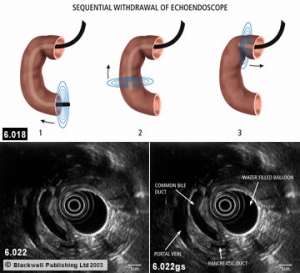Endoscopist

Endoscopes were developed to look at parts of the body that couldn’t be seen by any other way. Apart from this endoscopy has other uses in the prevention, early detection, diagnosis, staging, and treatment of cancer.
Endoscopy is a medical instrument used means to examine the interior of a hollow organ or cavity of the body. Unlike other medical imaging devices, endoscopes are directly inserted into the body.
An upper endoscopy, also referred as endoscopy, EGD, or esophago-gastro-duodenoscopy, is a procedure of examining the upper part of the gastrointestinal (GI) tract, which includes the esophagus, the stomach, and the duodenum.

There are different types of endoscope and depending on the organ in the body to be examine and the type of procedure. While a surgeon performs endoscopy procedure, the patient is either fully conscious or under general anaesthetic. Endoscope can also be referred to as a borescope in technical situations where direct line of-sight observation is not feasible.
Once the initial resuscitation is carefully performed endoscopy provides an accurate diagnosis of the source of the UGI haemorrhage and can reliably identify those high-risk subgroups that may benefit most from endoscopic hemostasis. Effective endoscopic hemostasis of ulcer bleeding can significantly improve outcomes by reducing rebleeding, transfusion requirement, and need for surgery, as well as reduce cost of medical care.
Endoscopes are also used to look for cancer in people who does not have symptoms like colonoscopy and sigmoidoscopy are used to screen for colon and rectal cancer. These procedures can also be helpful to prevent cancer because they let doctors to find and remove polyps (growths) that might become cancer if left untreated.
It is also useful to find symptoms for instance:
• Laryngoscopy to look at the vocal cords in people with long-term hoarseness
• Upper endoscopy in people having trouble swallowing
• Colonoscopy in people with anemia (low red blood cell counts) with an unknown cause
• Colonoscopy in people with blood in their stool
An upper endoscopy is used to diagnose and, sometimes, treat conditions that affect the upper part of your digestive system, including the esophagus, stomach and beginning of the small intestine (duodenum). Your doctor may recommend an endoscopy procedure to: Investigate signs and symptoms.
An endoscopy isn’t usually painful, and most people only experience some mild discomfort, similar to indigestion or a sore throat. The procedure is usually carried out while you’re conscious. You may be given a local anaesthetic to numb a specific area of your body.
Endoscopy is a safe procedure and when performed by a physician with specialized training in these procedures, the complications are extremely rare. … Major complications such as perforation (punching a hole through the esophagus, stomach, or duodenum) are rare but usually require surgical repair.
An upper endoscopy takes approximately 10 to 15 minutes. A colonoscopy takes approximately 15 to 30 minutes. How long will I be there after the procedure? Patients remain in the recovery area 30 to 40 minutes after their procedure.
